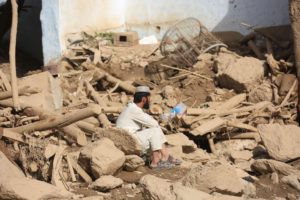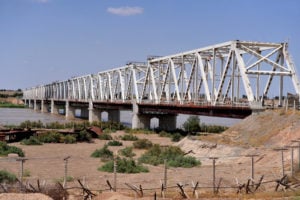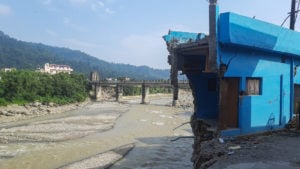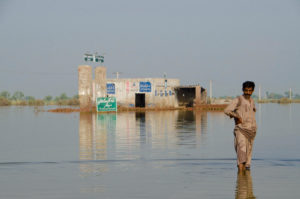Farming in Afghanistan has never been easy, says Ghulam Jailani, a 42-year-old farmer. But in the nearly 25 years he’s grown wheat on family land in the south of the country, nothing has been as destructive as the floods of July 2023. “It was terrifying. There was mud and water everywhere,” he tells The Third Pole. “We weren’t prepared for this kind of damage.”
Beginning late in the month, flash floods destroyed over 600 homes and hundreds of acres of farmland in Afghanista, according to Shafiullah Rahimi, a spokesperson for the Taliban’s State Ministry for Natural Disaster Management. He told Afghan media that excessive rainfall in central and eastern Afghanistan led to flooding in Kabul, Maidan Wardak and Ghazni provinces. An estimated 61 people died as a result. Flooding in the region continued in August, with videos on social media showing debris and mud cascading across settlements, razing homes and other structures.
“The floods also killed much of our livestock and destroyed some of the agriculture equipment we had invested in,” Jailani says. It has been a tough year for him, having also lost a substantial yield in May and June, just before harvest season. But Jailani was luckier than most. His neighbour was one of at least 41 people who went missing. “We still haven’t found his body, or signs of [it], in the surrounding areas,” he says, in early September, more than a month after the floods.
“It feels like the floods are getting more severe each year,” Jailani adds.
His feeling is rooted in scientific evidence. Afghanistan has experienced three consecutive droughts since 2020, each more severe than the last. Long droughts decrease the ability of the soil to absorb water, explains Assem Mayar, a water resource management expert and former lecturer at Kabul Polytechnic University. “Whenever there is a drought in the country, like we had this year, usually the monsoon rainfalls will result in flash floods.”
The monsoons typically come from South Asia, and cause precipitation in the mountainous central and eastern regions of Afghanistan, adds Sayed Abdul Baset Rahmani, an expert on water resources and former advisor to the Afghan Ministry for Disaster Management. “If those [mountainous] areas experience droughts [beforehand, the monsoons] can contribute to increased flooding.”
Jailani, who relies on rain and groundwater irrigation for his crops, says he has been forced to dig deeper wells for water over the last two years. “Each year, the water keeps getting lower and lower. It is getting very expensive to pump water since we need stronger pumps that require more fuel,” he notes. “Most of the year, we witnessed dry spells [that made farming harder] – and now the floods have destroyed it all.”
Low resilience against climate impacts
Experts say Afghanistan is facing a critical lack of infrastructure and leadership to deal with disasters brought on by climate change, the effects of which the country is already particularly susceptible after years of conflict and instability.
According to the Global Climate Risk Index, Afghanistan was ranked sixth among countries most affected by climate impacts in 2019 – the last year the index has data for. This is despite its carbon emissions per capita being 0.3 metric tonnes that year, far below the global average of 4.6 metric tonnes.
“After decades of war, Afghanistan does not have the resources or budget to build… resilience. We also don’t have the kind of governance that can deal with these [flood and disaster] events,” Rahmani says. This was highlighted when, after its takeover in 2021, the Taliban abolished the National Water Affairs Regulation Authority, an independent government body that had recently been established, as ReliefWeb reported.
There are currently only 28 meteorological stations in Afghanistan, which Rahmani says is insufficient for a country so geographically complex. “More worryingly, authorities are not working together to disseminate [the stations’] data to the people,” such as flood warnings, as well as information on dam and canal maintenance, he adds. The previous government used to publish reports and provide support on these matters, but this stopped when the Taliban took over, Rahmani says.
To help mitigate droughts and floods, Afghanistan requires a number of crucial infrastructural improvements, such as a more sophisticated network of dams and reservoirs to manage water flow, says Mayar. The country also needs to urgently maintain its existing reservoirs, many of which contain heavy sedimentation that limits their capacity to hold water. “This lack of infrastructure means that every time it rains, there are floods – and when the rains stop, there are droughts,” he says.
Another issue Afghanistan faces is a lack of early warning systems, Rahmani adds. Such systems can measure and evaluate water levels in rivers and other water bodies in real time, helping to “identify areas of concern, [so that] people there can be prepared.”
Climate change-induced disasters have and continue to be “major drivers of displacement” in Afghanistan, says Neil Turner, country director of the Norwegian Refugee Council (NRC), one of the few remaining international NGOs operating in the country. “Climate change has become a growing concern for communities across Afghanistan and severely affects the most vulnerable communities, including, not least, women and children,” Turner says.
Women in particular carry a disproportionate burden in emergency situations, he adds. “They are responsible for providing food, acting as heads of households and caregiving. Yet they lack any decision-making powers due to cultural norms.”
With the Taliban’s continued restrictions on women’s rights and movement in the country, and a likely increase in frequency of disasters, the constraints on women to act during such crises are feared to get worse.
A bleak future
Afghanistan’s situation is unlikely to change under the regime of the Taliban, who are not only ill-equipped to deal with climate impacts, but also face international sanctions and diplomatic isolation for their record of human rights violations. Experts are concerned about the impact this could have on the country’s climate change preparedness.
“Even under the previous government, Afghanistan only had a few projects that addressed climate change impacts, such as watershed management that can help reduce flood peaks, or recharging or retaining rain water in catchments,” Mayar says. “Though these projects did not meet all the requirements, they provided some support.”
But these projects were undertaken by various UN agencies and funded by international donors. Mayar highlights that “sanctions on Afghanistan have blocked funding towards these projects, and they have now all been suspended.”
Rahmani adds: “Afghanistan had also been part of different international forums – such as UNFCCC [UN Framework Convention on Climate Change] and the COP conference – where we could attract funds for some of the climate adaptation [projects needed]. But, unfortunately, we are no longer allowed to participate.”
As a result, he says, a number of projects for flood risk assessment, as well as the installation of new meteorological and hydrological stations, have been halted.
For the remaining few NGOs operating in the country, such as the NRC, acquiring funding has been an issue due to the sanctions imposed on the Taliban, alongside communication and logistical challenges, says Turner.
It will be very disadvantageous to disaster risk management efforts [if we] lose any of these crucial expertsAbdul Baset Rahmani, an expert on water resources and former advisor to the Afghan Ministry for Disaster Management
The issue of brain drain in the aftermath of the Taliban takeover affects the country’s climate change and disaster preparedness. Many professionals, academics and experts have had to leave Afghanistan to ensure their children are able to receive education, which, under Taliban rule, is banned for girls beyond primary school.
This could create a knowledge gap that leaves Afghans unprepared for future climate disasters. Rahmani points out that for integrated water management in particular, it is crucial for Afghanistan to have professionals with knowledge of disciplines such as water sciences, social sciences, economics, environment, law and agriculture – all of which require understanding of the local context. “It will be very disadvantageous to disaster risk management efforts [if we] lose any [more] of these crucial experts,” he says.
Experts sound the alarm
Without improvement in governance and infrastructure, future flood events in Afghanistan could have a devastating impact, says Rahmani. “Years of war and conflict has limited us [from] proper planning in resiliency and the mitigation of natural hazards. Meanwhile, the impact of climate change is increasing.”
He notes that, based on data gathered by his team under the previous government, floods will occur again in central Afghanistan, specifically on the geographically vulnerable Kabul river basin, which crosses 12 provinces in northern and eastern Afghanistan. “Without a doubt, there will be [even more] casualties, and loss of livestock and property, if we don’t introduce warning systems, improve infrastructure or even raise awareness among the people [about] preparing for such disasters,” Rahmani says.
In light of these disasters increasing, it is important to impart additional knowledge and technologies to rural communities so that they can help preserve scarce water resources, Turner says. “Working closely with the [rural] communities to improve awareness of climate change and establish sustainable coping mechanisms is critical to improving people’s lives and avoiding displacement within Afghanistan.”
According to both Mayar and Rahmani, the best way to make this happen would be for international donors that are wary of the Taliban to directly engage with Afghan communities on these issues through local NGOs. Mayar highlights how the United Nations flew in cash to fund its operations, bypassing the Taliban.
“The Earth only has one atmosphere and global warming harm transcends political boundaries,” Mayar had warned in his paper in the Afghan Analyst Network last year. To deal with the increasing risks of disasters in the country, “there is an urgent need to improve people’s resilience against droughts, and community preparedness to climate events,” he says.
“People need a supporting hand. Otherwise, the next event will be catastrophic,” Mayar adds.









